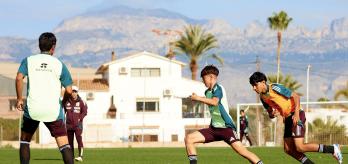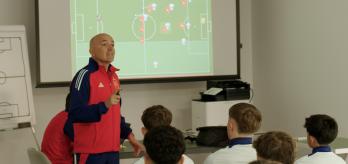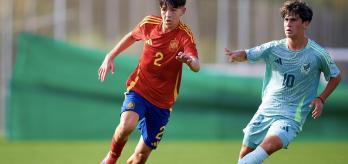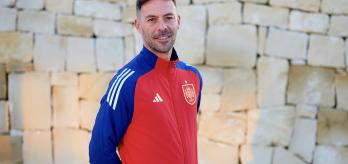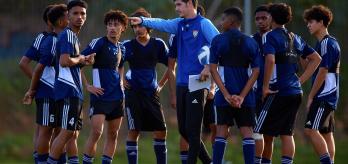When matchday is approaching, a team will often work on exercises that will help them to prepare for the opposition. In this matchday-1 session, the team work on defensive actions that will help them combat their counterparts’ attacking strategies, meanwhile, they also focus on their build-up play, a range of attacking patterns and set pieces.
In this session, fitness coach Jesús Mentado Aburto, head coach José Antonio Castro and assistant coaches Omar Tapia and Israel Hernández present a series of exercises to prepare their team for the opposition. The session starts with a warm-up split into four parts to get the players ready for the exercises ahead. The second exercise is a series of unopposed attacking patters of play and defensive actions from crosses. The third exercise is an 11v11 attack v. defence that focuses on pressing high and building-up in a 4-4-2 diamond. The session ends with set pieces that prepare defenders for their marking actions and the attackers for the movements required for different routines.
Session overview
Key coaching points
-
Sharpen the players’ coordination skills by making the warm-up fast and as responsive as possible.
-
Insist on precise passes and synchronised movements when practicing patterns of play in a 4-4-2 diamond shape to build up against a 4-3-3.
- Defenders must hold a good line and be well-orientated when defending crosses, making sure to attack the delivery.
- When pressing in a 4-4-2 diamond shape, try to orientate the opponent into crowded central areas to force turnovers.
- If the opposition look to bypass the high press by playing long, players must be alert and ready to win the first or second balls.
- Players must understand their roles at defensive set pieces, adjusting their positioning and behaviour accordingly whether they are marking player-to-player or zonally.
- Players must be aggressive when marking individually not to lose their mark, when attacking the ball or when making decoy runs to open spaces for team-mates to attack.
Part 1: Warm-up
This session begins with a series of activation exercises split into four parts that focus on aspects such as core strength, stretching, speed and coordination to help the players prepare for the session ahead.
Organise four parts of the exercise as follows:
-
Part A – Provide an exercise mat and a small stretch band for each player as well as a large stretch band for every two players.
-
Part B – Place some poles in the ground and lean them at a 45-degree angle. Players take up a position at one end of the line of poles.
-
Part C – Set up 9 poles in a line with a vest placed on top of each pole. Position a player either side of each pole. For the second section, place 2 cones 15m from a starting point and line up the players in rows of 2 at the starting point.
-
Part D – Lay down 9 hex hoops in rows of three, 15m from a starting point. Split the group into teams of five or four, with 2 players from each team facing off against each other. One team should have 3 blue vests and the other team should have 3 red vests (1 per player).
Follow the instructions for each part.
-
Part A: General mobility and stretching – Perform a series of stretches and core exercises, such as foam roller stretches and stretch band exercises with the legs and with a team-mate.
-
Part B: Lower body mobility – The players perform leg raises over the poles as they move from one end to the other.
-
Part C: Fun speed and mobility game– The coach will call out a series of instructions.
-
If the coach calls “left” or “right” the players must rotate in that direction.
-
If the coach shouts “turn”, the players must spin around.
-
If the coach calls out “blue”, the players must try to grab the blue vest off the pole that they are facing before the other player.
-
-
Part D: Tic tac toe game – One player from each team must sprint towards the hex hoops and place a vest in one of the hoops.
-
The next player in line must do the same, with each team trying to place their vests in a row of three to win.
-
Once all of the vests have been placed in the hex hoops, new players must pick up one of the vests from the hoops and try to create a row of three for their team.
-
-
Progressively raise the intensity of the exercises and ensure that players are well stretched before proceeding.
-
Create a light and fun but competitive environment so that players enjoy the exercises and work towards an objective.
Part 2: Unopposed attacking patterns of play and defending crosses
This finishing activity works on various attacking patterns that the team wish to implement during matches. The second objective of the exercise is to work on defensive clearances, and the third part focuses on the scanning ability of midfielders.
-
Use a full-size pitch.
-
Use a full-size goal and place a goalkeeper at each end.
-
Position mannequins across the pitch in a 4-1-4-1 formation.
-
Position the players in a 4-4-2 formation with 2 midfielders deeper than the other 2.
-
Spare players should wait by the mannequins close to their position.
First phase
-
The ball starts with the goalkeeper, who passes to one of the defenders.
-
The defenders must shift the ball to one side before recirculating the ball to the other side. As the ball circulates, the opposite full-back pushes on high and a midfielder drops back into the full-back position to receive.
-
During the build-up action, a coach at the far end holds up cones of different colors. The central midfielders must call out the colors being shown, requiring them to constantly check and scan their shoulder.
-
The midfielder, receiving wide, must progress the ball into attack by passing to the number 9, who lays the ball off for an advancing attacking midfielder.
-
The attacking midfielder then finds the full-back attacking the wide area who crosses for four attackers arriving into the box.
Second phase
-
Once the ball has been progressed into attack, the defenders must defend a cross.
-
2 spare midfielders look to attack the penalty area, while another goes out wide to receive and cross the ball.
Third phase
-
Once the ball has been cleared, the midfielder who was not used must pass into the coach and take a shot at goal.
Variation 1
-
The attacking pattern is executed on the opposite side.
Variation 2
-
The attacking pattern varies with a through ball into the opposite winger, who runs in on goal.
Variation 3
-
The progression tries to draw the opposition full-back out so that the number 9 can run into the space left behind.
-
Precise, sharp and accurate passes should be the main focus of the players in possession.
-
Players must synchronise their movements and actions to promote fluid attacking patterns.
-
By constantly scanning, midfielders can spot progressive passes faster and be alert to any pressure coming on their backs.
-
The number 9 should try to drop back to connect and link the attack.
-
When defending crosses, defenders must maintain the correct body orientation to be able to keep both the ball and their opponent in sight whilst being well positioned to attack the ball.
Part 3: 11v11 attack v. defence
This activity focuses on the team's organisation in a 4-4-2 diamond against a 4-3-3 in two different phases of the game. The first part of the 11v11 game is based on a coordinated high press against a team building up from the back, and the second part focuses on building an attack from the back while under pressure.
-
Use a full-size pitch.
-
Use a full-size goal and place a goalkeeper at each end of the pitch.
-
Split the players into two teams of 11.
-
The orange team should take up a 4-4-2 diamond formation.
-
The blue team should be positioned in a 4-3-3 formation.
Defending
-
The exercise always starts with a goal kick for the blue team.
-
The blue team must build up play and look to progress the ball.
-
The orange team must use a coordinated high press with a diamond midfield.
-
The objective is to disrupt the orange team’s build-up, win the ball and score.
Attacking
-
The orange team starts with a goal kick.
-
Players must try to progress the ball through or over the press by using a diamond midfield.
-
The strikers should exploit the vacant space on the wings when the opponents' fullbacks are drawn out.
-
Pressing players must prevent any passes between the centre-back and full-back and try to force the opposition into making a mistake or to play long.
-
If the ball is played wide to one of the full-backs, wide midfielders should jump out to apply pressure on the ball as quickly as possible.
-
Defenders and deep-lying midfielders should be proactive to challenge for first and second balls if the ball is played long.
-
Read and adjust starting positions to press effectively. For example, staying between two opposing players can cause doubts and force the ball carrier into making a mistake.
-
When building up from the back, players must read and anticipate play according to the opposition's movements and organisation.
If the opposition winger jumps out to press the full-back, passing options can open up for the wide midfielders to exploit.
If the opposition full-backs are attracted into midfield, players should recognise opportunities to play long into the two forwards who can exploit the vacated spaces out wide.
Part 4: Defensive and attacking set pieces
The final section of this session focuses on set pieces and is divided into two parts – defending and attacking.
-
Use one half of a full-size pitch.
-
Use a full-size goal with a goalkeeper.
-
Split the players into two teams.
-
One team defends and the other attacks.
-
For each set-piece drill, the players must take up different positions – see the images and explanations below.
Corner kick
-
5 defenders marking player to player.
-
2 defenders marking zonally at the edge of the box and are ready for second balls.
-
2 defenders positioned at the front post marking zonally.
Wide free-kicks
-
Seven defenders, positioned in a line, defend zonally on the edge of the penalty area.
-
2 defenders in a wall in front of the ball.
-
One defender positioned on the edge of the D to protect the area for possible second balls.
Corner routine 1:
-
5 attackers position themselves centrally between the penalty spot and the edge of the penalty area. Those five players are running to the near post to pull the defenders with them and create space at the far post.
-
2 attackers wait on either side of the D. One of those players takes advantage of the decoy runs from his teammates and sprints toward the target space around the far post.
Corner routine 2:
-
Position 4 attackers on the edge of the penalty area and 1 on the edge of the D. The 4 target players cross their runs and sprint toward the near and far posts.
-
Position 1 attacker by the goalkeeper. As the corner is taken, the player drops back toward the penalty spot.
Wide free-kick:
-
Position 5 players in the penalty area: 3 on the line of the near post and 2 closer to the far post. 2 players are positioned at the edge of the box.
-
The players starting from the far post move toward the near post, trying to block the opponents from their teammates who are moving toward the target space at the far post.







